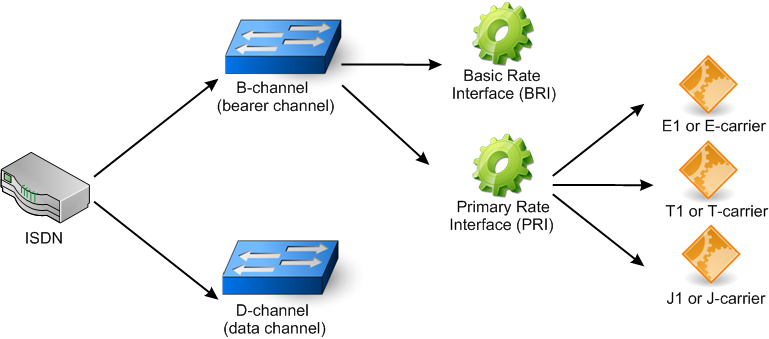E1 vs. T1 vs. J1
In this page you can get informed about the three types of PRI, the E1, T1 and J1. PRI and the three forms of it are important in the ISDN networks, so if you are the one who intend to create an Internet-based telecommunication system it is a must to be familiar with these terms. Fortunately, you can have all the basic knowledge you may need from this page.
ISDN digital circuits
The ISDN network consists of numerous units; what we would like to introduce among them in this section is a digital circuit, a level of service of the ISDN. Let us see how can the ISDN manage these digital circuits and the data transfer.
ISDN can work if there are two types of channels, the B-channel (bearer channel) and the D-channel (data channel). The B-channel is used for carrying the data content through the network, the D-channel is for carrying the signaling and supervisory information.
According to the number of the B- and D-channels, two types of interfaces can be distinguished: the Primary Rate Interface (PRI) and the Basic Rate Interface. The Basic Rate Interface always consists of two B-channels and one D-channel. BRI is used by individual users and small companies.

PRI E1, T1 and J1
Again according to the number of B-channels and D-channels, there are three types of PRIs:
- E1 or E-carrier: it contains 30 B-channels and one D-channel and used in Europe
- T1 or T-carrier: it contains 23 B-channels and one D-channel and used in the USA and Canada
- J1 or J-carrier: this is almost the same as T1 but used in Japan with some slight modifications, this is the Japanese standard for PRI
In all cases each B-channels can manage 64 Kbs data transfer: it means that you can get the data with an E-carrier with 2048 Mbps and 1.544 Mbps in the US, Canada and Japan.
Both BRI and PRI can be used in the case of traditional PSTN (Public Switched Telephone Network) systems and for Internet connections.
The Useful PRI
The three types of PRI, in opposite to BRI, are used in large companies for the extended communication. PRI can be used for connecting PBXs (Private Branch Exchanges, servers) together and the PBXs and the company's extensions.
But why is it important? Because if you intend to have an advanced, ready-for-every-chance communication system, you will need a PBX and the proper connections: with Ozeki Phone System, you can have all these ready for use, without wasting time and effort for the building up of the network.
The Ozeki Phone System is capable to handle all types of PRI, so you can make multimedia calls to all over the world without trouble. With the Ozeki Phone System, international communication becomes available in high quality, with numerous features that make your work easy and effective.
To get more information about ISDN and Internet Telephony, take a look at our related pages:
